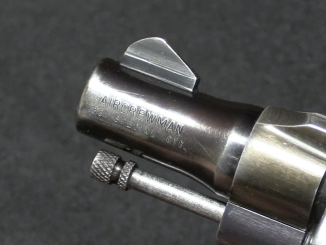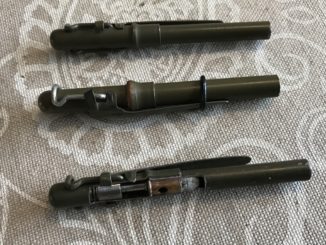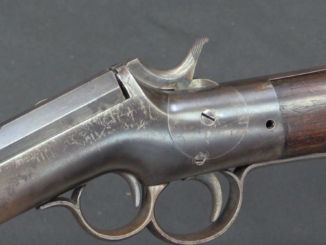Today I am taking a look at Savage automatic pistols as a general group. Savage produced about a quarter million pistols in both .32 and .380 caliber, divided between the models 1907, 1915, and 1917.
What are the differences, and what was the timeline of their development? I’ll go through all of this, and also some of Savage’s memorable advertising and the basic disassembly process. This should answer all your questions about why some have hammers and some don’t (actually, none of them have hammers, technically…) and what’s up with those two different frame shapes.




A very nice presentation on my favorite pocket pistols.
The early lever safety / metal grip 1907 is in remarkable shape.
Your estimate of prices is generally accurate, but a high-condition 1915 .380 will be anything but “modestly priced”.
Thanks for a nice video.
“Savage’s memorable advertising”
Click here: http://vintagepistols.com/1907/ad0.html?adid=0
and hover mouse over ADVERTISING in green bar too see available scans of vintage Savage pistol adverts. As you can see Savage produced many adverts.
Most common states: “10 shots QUICK [AS LIGHTNING]” and “AIMS EASY AS POINTING YOUR FINGER”
Portugal adopted the 1907 as a service pistol. My understanding is that France purchased some in WWI along with all the Ruby ,32s from Eibar and Euskadi.
You show all the easy to find ones. I have seen a couple of collections displayed at gun shows that this collection represents something like .0083% or .021% of all the Savages made. They made a very few pre-production 25 acp guns I had a friend who traded a large pile of nice Lugers and Mauser broomhandels for one of those 25 acp ones. He allowed me to shoot one of his 2- 45acp U.S. test pistols but never the 25.
I know that:
Colt produced Colt Model 1903 (Hammerless)
Savage produced Model 1905
H&R produced their .32 automatic pistol (developed from Webley Scott automatic pistol)
Remington produced Model 51
but I didn’t heard about any early 20th century Winchester automatic pistol; did Winchester considered production of any automatic pistol in 1900s-1910s? If not – why?
I forgot about S&W Model 1913
The story that is told about this is that in retaliation for Colt coming out with the Colt-Burgess lever action rifle in 1883, (which was itself in retaliation to Winchester importing and re-branding a bunch of English double shotguns to compete with a Colt double shotgun introduced in 1878), Winchester had head-hunted designers from Colt and Smith & Wesson and had them come up with revolver designs that would compete with the Colt Single Action Army. It is said that Winchester and Colt’s chief executives had a meeting where they agreed that Colt could not make any money manufacturing long guns, and Winchester could not make any money manufacturing handguns. This gentleman’s agreement lasted a good long time.
Now, imagine this, if that agreement hadn’t been in place, Hugo Borchardt was working at Winchester in the 1870s. ^__^
“Now, imagine this, if that agreement hadn’t been in place, Hugo Borchardt was working at Winchester in the 1870s. ^__^”
This might cause that swing-out cylinder revolver would become popular in 1870s-1880s, not 1890s-1900s as in real time-line.
“Colt could not make any money manufacturing long guns, and Winchester could not make any money manufacturing handguns”
I am not expert on post 1950s fire-arms, manufacturers e.t.c in United States but:
Colt produced XM177 in 1960s, it is not hand-gun, so why Winchester didn’t immediately respond with its handgun?
The introduction of the swing-out cylinder revolver had to wait until the William Mason patent of 1866 expired. It was held by Remington, and like the Rollin White bored-through cylinder patent held by Smith & Wesson from 1857 to 1869, it pretty much prevented anyone but Remington making revolvers of that type.
It must have especially irked Mason, because in 1868 he went to Colt to work with C.B. Richards on metallic-cartridge conversions. His first swingout cylinder revolver for Colt,in 1884, was literally put into production the same day the Remington patent expired.
cheers
eon
My guess is this, since Winchester wasn’t its own company in the 1950s, (it was a “brand” owned by Olin Industries), and since they had made a disastrous foray into diversification at the end of World War 1, their corporate leadership probably avoided diluting the brand by going into handgun manufacture. After all, that hadn’t worked out very well for Remington and Savage in the long run.
Winchester had new management and they embarked on a campaign of cost-cutting in the early 1960’s. That is why collectors refer to pre-1964 and post-1964 Winchester rifles. The cost cutting was widely seen as quality-cutting. Today a used Winchester model 70 rifle from 1963 might go for several hundred dollars more than a 1964 model. My impression is that Remington had introduced some very good designs (the model 700 rifle and the 870 shotgun). Instead of making innovative designs to catch up, Winchester cut corners.
As the others have written, Winchester was busy with other things in that time period. They were trying to cut costs and they were having a hard enough time protecting their market share in rifles and shotguns to try to figure out how to make handguns.
Yep, France bought a bunch of 1907 Savage pistols for WWI. They were all .32 acp versions, and can be identified by the addition of a lanyard loop on the lower rear of the grip frame.
The video ends rather abruptly at 10:15 just after releasing the magazine on the last model. There was no summary or closing statements. Is this deliberate or is the end of the video missing? I’ve watched twice, and it was the same both times.
At least 2 items intrigue me on Savage pistols. First is their cast like (investment cast, actually) appearance and second is their rich glossy finish. Both are splendid and testimony of mass manufacturing techniques of those days. Quite amazing.
The post World War I guns had a matte finish. You’ll often see the late production 1907 pistols with the more serrated slide pull, rounded cocking indicator (“hammer”), and a finish that looks a lot like Parkerizing. Savage probably changed the finish to hurry up production to fulfill post-war demand.
“Savage probably changed the finish to hurry up production to fulfill post-war demand.”
Yep, one of their advert (see here: http://vintagepistols.com/1907/ad5.html?adid=5 ) it says:
“(…)We’re working hard to get your to get you the guns that you’ve unselfishly and patriotically waited for so long(…)”
The Savage rotating barrel isn’t a true locking mechanism nor a true delay mechanism. It was thought that the friction of the bullet on the rifling would put a rotational force on the barrel and lock it in place until chamber pressure became safe. This didn’t happen, so one wonders why.
The MAB PA-15 has a similar system but torque from the French pistol’s rotating barrel acts on its upper lug against a notch in the slide (which is trying to open due to gas pressure from the cartridge casing). When the bullet clears the muzzle, the slide overcomes the barrel lug and extracts the spent casing. The barrel does not reciprocate, which means that recoil is pretty harsh compare to recoil from a Browning Hi-Power or that from a Walther P-38.
Did I flub anything?
Nope. The Steyr M1912 9mm uses a similar rotating-barrel lock, as does the Mexican Obregon .45 ACP, which looks like a 1911 with an oddly rounded forward slide section (to accommodate the rotating locking system);
https://upload.wikimedia.org/wikipedia/commons/b/b7/Pistol_Obregon_1.jpg
Like the MAB, the Steyr and Obregon are noted for their rather “brisk” recoil, which strongly indicates that they are closer to delayed-blowback than true locked-breech systems.
cheers
eon
Very nice video. Good job Ian. I have magazines in my collection with both holes on the back.
Just wondering as a “cocked and locked” 1911 type, would these Savage pistols been carried with a chambered round and the safety on or carried with the chamber empty? As a striker fired pistol, I guess the option of round chambered but “hammer” lowered wasn’t available.
The manual stated that the pistol was “perfectly safe” to carry in Condition One, “cocked and locked”, with a round in the chamber, “just like other pocket automatics”, a reference to Colt and FN .32 and .25 autos, which were also concealed-hammer types.
The difference was that the Colt/Browning designs all had grip safeties, something Savage didn’t acquire until the 1915 model, and dropped on the ’17. Of course Browning and Saive deleted the grip safety on the M1935 High Power, so maybe John Moses and/or Dieudonne didn’t think it was all that vital either.
In the dresser drawer, the Savage was to be left in either Condition Two (hammer down on a loaded chamber) or Three (loaded magazine, empty chamber, hammer down). The idea being that you’d have a bit more time to prepare in a home-defense situation. In one of his ads, “Bat” Masterson stated that the sound of the slide going home on a Savage was itself a deterrent to a burglar who wanted to remain upright.
Probably not as much as the pump being racked on a Winchester ’97 or ’12 twelve-gauge, though.
cheers
eon
FYI, dropping the rounded “hammer” on one of these on a loaded chamber is not easy. And, as far as I know, the firing pin rests on the primer with the full pressure of the striker spring behind it. I do not believe this gun would pass the drop test with the striker down on a loaded chamber.
Also, if you saw how the “safety” works on this pistol, I don’t believe anyone would trust it.
Personally, I would not carry this gun for self defense, and if I carried it loaded into the field it would be HAMMER DOWN on an EMPTY chamber.
This pretty much confirms what I’d suspected by looking at a friend’s M’17 when I was in harness. He carried it as a backup on duty, after it had gone through WW2, Korea, and VN as first his dad’s and then his older brother’s hideout gun.
One thing I noted was that any round in the chamber when the pistol was in Condition Two had a distinct indent in the primer due to firing-pin intrusion. The Savage was touted as having a true “inertial” firing pin, but I’ve always had doubts about that.
Of course, I don’t have much room to talk. My “stingy” gun was a Mauser M1910/34 in .32. It had to be carried Condition One or Three as there was no way to achieve Condition Two without firing the piece. However, its manual safety (right behind the trigger) was a good bit more secure against accidental release than most thumb safeties on pocket automatics.
Eventually, I noticed that nobody really noticed what I had under my jacket, shirt tail, etc. Therefore, I retired the Mauser and changed to a Colt Lawman MK III 2.5″ .357.
Yes, I carried it with six rounds. The transfer-bar action made that entirely reasonable. And I figured that six rounds of .357 beat eight rounds of .32 any day of the week.
cheers
eon
IIRC this arm was officially endorsed by “Bat” Masterson.
A PDF of the Bat Masterson booklet on the Savage pistol is available for free download here:
http://www.thetruthaboutguns.com/2013/10/robert-farago/ttag-exclusive-gunfighter-bat-mastersons-the-tenderfoots-turn/
How does one “hold the cocking piece down & rotate it 90deg clockwise” on the m1915’s for takedown, when the m1915 has the covered cocking piece? Other than that bit of missing information, this was an especially enjoyable episode, thanks!
The slide is pulled back and locked and the cocking piece can be pushed up from underneath and rotated 90 degrees to detail how from the slide.
Should read “detach from slide”. Freaking spell checker going nuts.
I recently acquireda 1917 and have been looking for extra magazine. Anyone recommend the Sarco or TrippleK? any idea why they are 8 and 7 round instead of the original 10?